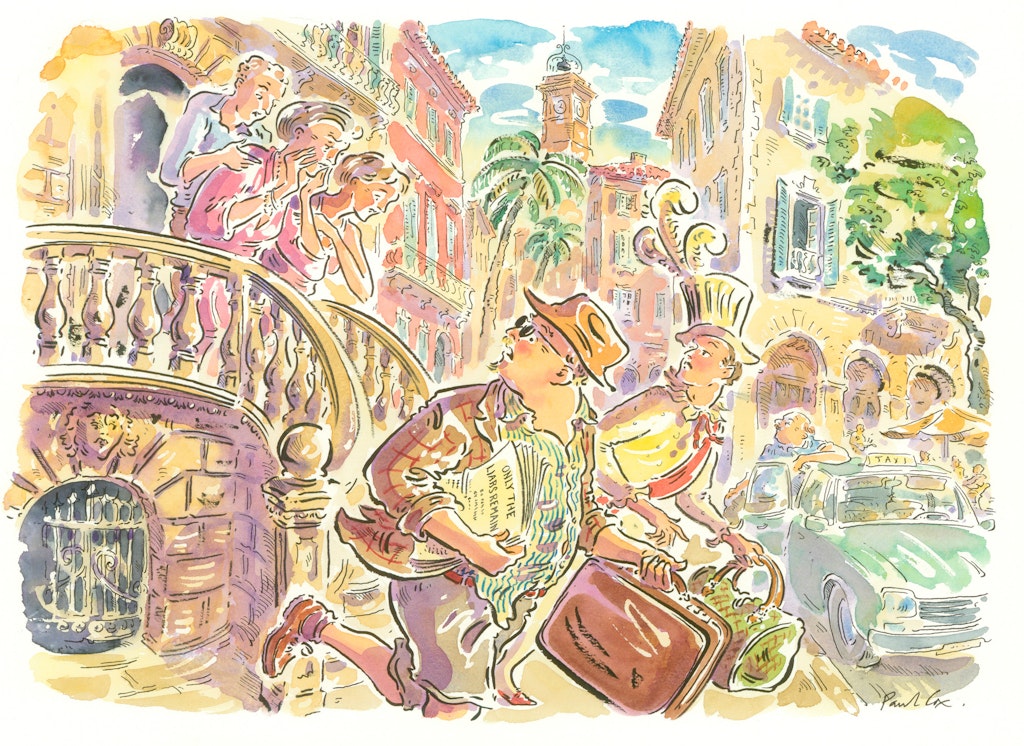Reclaim the streets
Too many of our town centres have become hollowed-out, windswept deserts. But if we make them fit for people, they will return
Which century saw the creation of more new towns than any other in English history? The prosperous industrial nineteenth? The booming mercantile eighteenth? Merrie England in the sixteenth? The answer is none of the above. The great age of town-making was the twelfth and thirteenth centuries, an era of chartered markets and royal warrants, of sheep fairs and market crosses.

Some foundered. Though Seacourt in Oxfordshire once supposedly had 24 inns, who has heard of it now? But most prospered. They did so because they were well situated and provided what their neighbourhoods required: a safe and pleasant place for citizens to congregate and conduct business.
To understand this is to understand why so many of England’s towns in both prosperous areas and in poor ones are underperforming. A town is a place where people wish to come to meet, to converse, to buy, to sell and to be amused in the process. But too few of England’s town centres, even those which are superficially successful, are places where anyone would choose to be. They have lost their purpose.
This is categorically not just a tale of former industrial towns or abandoned Victorian coastal resorts. Take the town of Maidenhead in Berkshire. It should be humming. Theresa May’s constituency, in England’s self-proclaimed M4 “silicon corridor”, is only 20 miles from London and down the road from Windsor. Where could be wealthier? Jobs abound and in the surrounding Berkshire countryside new wealth meets old.
Yet the centre is not humming — certainly not with people. The railway station is cut off from the town by a furious dual carriageway, acres of parking and lumpen office blocks. Fight your way through to something that passes for a town centre and you immediately find empty shops, failing shops and strip bars. Up the road, the high street is deserted for such a large town, has units to let and a meagre collection of chain stores. It ends abruptly in another dual carriageway.
Maidenhead town centre is not a place to meet but a place to drive through — and fast. Prosperous neighbours from surrounding villages or suburbs do just that. They meet elsewhere. Not all towns are depressed. But nearly all are less prosperous then they could be. Visits to town centres have fallen by 17 per cent over the last decade. And more than one in ten shops have stood empty for more than a year.
Meanwhile their populations are ageing. In the 30 years up to 2011, British small towns and villages lost more than a million under-25s and gained 2 million over-65s. Large cities gained more than 300,000 under-25s and lost around 200,000 over-65s. Towns are for baby boomers. Certainly, the town centres of many large cities (above all London) have flourished over the last generation while small-town Britain has, largely, aged and withered.
The local bank manager in Walmington-on-Sea isn’t Captain Mainwaring but a 25-year-old applied sales specialist
Why is this? Why is the geographic dispersal of wealth changing in this way? The social enterprise that I run, Create Streets, examines the history of places, conducts statistical research into relationships between urban design and health, popularity and prosperity, and works practically on the ground to help communities, landowners and councils to revive their neighbourhoods. What have we learnt about what’s gone wrong and how to put it right?
We think there are three big elements. The first is a profound failure of governance. For hundreds of years, English towns had been run by their corporations and alderman, regulating their markets, managing almshouses, licensing traders. Some were active. Some were sleepy. No doubt many were modestly corrupt. But the fortunes of the merchant mayors and councillors were tightly tied to that of their towns and, on the whole, they governed quietly.
No one could accuse twentieth-century town councils of lacking ambition. Overawed by town architects such as Donald Gibson in Coventry — who described German air raids as “a blessing in disguise” — and by prophets of “traffic modernism” as preached by the Architectural Review, they confused the intoxicating freedom of a rare car on a 1930s country road with how our towns centres should function.
The careful accretion of beautiful, practical human-scaled streets and squares — good for trading and talking, for meeting and living — was thus brutally swept away in the name of a false vision of progress: fast roads and overly-scaled, under-detailed buildings. Complex and adaptable towns were replaced with urban monocultures, often under single ownership which were unable to evolve.
For centuries, town centres attracted people to live in them. But now, appalled at their inhumanity, those with the means to choose flee the town centres for the new suburbs or the newly-accessible countryside. It is notable that many towns that are relatively prosperous today, not counting the commuter belts of large cities, are the towns which were the least desecrated — places such as York, Ludlow or Bath.
The second theme is one of comparative advantage. After 50 years of decline, British cities have become much better and more profitable places to live and work. This is the new urban renaissance and has been partly environmental (clean air since the 1950s); partly economic (since the 1980s); partly generational as millennials seek different lifestyles to their parents. Above all, it has been technological — in complete contrast to most futurologists’ predictions, the “global village” has actually increased the tendency for the smart and the footloose to cluster together, becoming provably more productive, inventive and richer in the process.
In turn, city councils have started understanding how to correct the disastrous errors of their predecessors, with streets being reimagined as places for people, not motor cars. Waltham Forest in east London has done just this, closing roads to traffic and seeing an increase in footfall and successful shop openings. In short, British cities are being rehumanised. People go where people are. But the cities’ gain is the small towns’ loss.
The hollowing-out of local civic society is the third theme. Seventy years ago, any private or public sector body needed local managers and leaders of talent and experience: local bank managers, branch office managers, union representatives. Then, the cost efficiencies of supermarkets or national firms were not sufficient for them to outcompete locally-run butchers, bakers or accountants. How that has changed over two generations. The very same financiers and innovators who “cluster” in London or New York have been able to create data flows and management methods which have sidelined and infantilised local management.
There are advantages to this: cheaper products and services for consumers. But there are consequences too. The local bank manager in Walmington-on-Sea is no longer Captain Mainwaring, but a 25-year-old with a course in applied sales. Residents can no longer walk around the corner to the butcher’s shop; it is easier to drive to the supermarket. In addition, internet shopping has savaged local shops that, unlike their online competitors, face the burdens of rents and local business rates. High street shops are closing and being left empty in wealthy areas as well as the less prosperous.
Politicians have woken up to the slow death of England’s towns. Last year, the Labour Party ran a deservedly successful political broadcast called “Our Town”. In the recent election, Labour’s manifesto proposed a Town of Culture competition and money to encourage cycling, walking, more people-friendly street design and cleaner air zones around schools. Similarly, since Boris Johnson became prime minister, the government has announced a flurry of spending announcements, including millions for high streets and £3.6 billion for 100 towns (45 across the “Northern Powerhouse” and 30 in the “Midlands Engine”) with “proud industrial and economic heritages”. The Conservative manifesto supported street trees, cuts in retail business rates, local libraries and cycling infrastructure.
But do politicians have the right answers? Some on the left seem to think the only answer is more public ownership, as if huge swathes of British towns are not already publicly owned. And some on the right seem to think it is all about investment in new roads, as if excellent “hard infrastructure” — fast roads to you and me — running through or round town centres are not already doing irreparable harm to towns such as Leicester, Guildford and Coventry.
It is increasingly possible for workers to live and work in towns such as Shaftesbury, Salisbury or Rugby and commute in once or twice a week
If Britain is truly to prosper, we need stronger towns. This doesn’t mean naive “regional development policies” to “pick winners” or to subsidise employment where it would not otherwise go — the jobs tend to end when the subsidy evaporates. But it does mean allowing our towns to rediscover their true purpose as a place for people profitably to congregate for business and pleasure. And that will normally mean helping them become cleaner, more pleasant places in which it is easier and cheaper, to live, work, spend time, set up businesses and raise children. Towns like Bradford, Altrincham and Macclesfield are starting to achieve this through partially community-led high street revitalisation.
A simple and predictable planning framework is required so that many landowners and private citizens can set up businesses, start shops and create homes without making towns uninhabitable for everyone else. A thousand flowers need to bloom if our towns are going to be flexible and resilient in an unknown future.
Town councils need to think more like the corporations of old, which properly examined the commercial payback on money spent. If they did, as analytical work on infrastructure economics is increasingly showing, they would realise that many large infrastructure investments are often not worth the candle. And they would realise they have to reduce business rates if high streets are to compete with the footloose online franchises.
Fortunately, what the technological gods take with one hand they give with the other. Cities attract with their excitement and opportunities. But they repel with their high costs and stress. Thanks to digital technology, it is increasingly possible for workers with young families to live and work in towns such as Shaftesbury, Salisbury or Rugby and commute in once or twice a week, as necessary, to London, Bristol or Birmingham. If high streets lose some of their shops, smart towns will let high streets evolve into places to meet and work as well. The recent revival of the high street coffee shop is a pleasing return to the future in the history of convivial capitalism.
This should be our aim — not hollowed-out “business districts” but strong, towns that worry about the soft more than hard infrastructure and make it easy for their citizens to flourish, experiment and invest within a clear planning policy that values beauty and liveability.
All politics is not local. Politics is place. Most of our towns are nearly 900 years old. Treat them with a little love and they will be good for thousands more to come. For all our technological advances, people, after all, are still the same.
Enjoying The Critic online? It's even better in print
Try five issues of Britain’s most civilised magazine for £10
Subscribe














